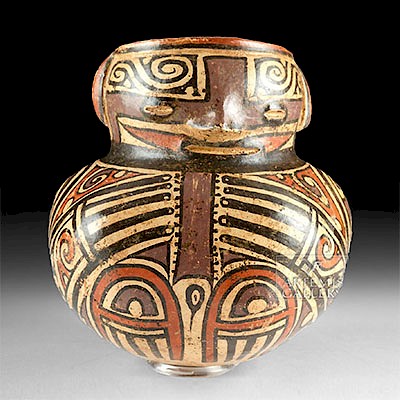1837 Color Lithograph Hunting the Buffalo, Rindisbacher
Lot 131a
About Seller
Artemis Fine Arts
686 S Taylor Ave, Ste 106
Louisville, CO 80027
United States
Selling antiquities, ancient and ethnographic art online since 1993, Artemis Gallery specializes in Classical Antiquities (Egyptian, Greek, Roman, Near Eastern), Asian, Pre-Columbian, African / Tribal / Oceanographic art. Our extensive inventory includes pottery, stone, metal, wood, glass and textil...Read more
Estimate:
$2,500 - $3,750
Absentee vs Live bid
Two ways to bid:
- Leave a max absentee bid and the platform will bid on your behalf up to your maximum bid during the live auction.
- Bid live during the auction and your bids will be submitted real-time to the auctioneer.
Bid Increments
| Price | Bid Increment |
|---|---|
| $0 | $25 |
| $300 | $50 |
| $1,000 | $100 |
| $2,000 | $250 |
| $5,000 | $500 |
| $10,000 | $1,000 |
| $20,000 | $2,500 |
| $50,000 | $5,000 |
| $100,000 | $10,000 |
| $200,000 | $20,000 |
About Auction
By Artemis Fine Arts
Nov 8, 2018
Set Reminder
2018-11-08 10:00:00
2018-11-08 10:00:00
America/New_York
Bidsquare
Bidsquare : Ancient / Ethnographic From Around The World
https://www.bidsquare.com/auctions/artemis-gallery/ancient-ethnographic-from-around-the-world-3598
Ancient art from Egypt, Greece, Italy and the Near East, as well as Asian, Pre-Columbian, Native American, African / Tribal / Oceanic, Spanish Colonial, Russian Icons, Fine art, much more! Artemis Fine Arts info@artemisgallery.com
Ancient art from Egypt, Greece, Italy and the Near East, as well as Asian, Pre-Columbian, Native American, African / Tribal / Oceanic, Spanish Colonial, Russian Icons, Fine art, much more! Artemis Fine Arts info@artemisgallery.com
- Lot Description
Peter Rindisbacher (Swiss, 1806-1834), an original hand-colored lithograph entitled "Hunting the Buffaloe", 1837. Just three years after Peter Rindisbacher's death, his "Hunting the Buffaloe" was selected to be the frontispiece for the first volume of the folio edition of "The Indian Tribes of North America, with Biographical Sketches and Anecdotes of the Principal Chief" - a three volume collection of large-scale plates of paintings depicting Native Americans, published in Philadelphia by Edward C. Biddle for Thomas L. McKenney and James Hall (Mckenney and Hall), 1836-1844. Rindisbacher skillfully delineated this dramatic rendering of an Indian wearing traditional dress and chasing and aiming his arrow at a wounded buffalo while on horseback. Size: 16.25" W x 11.375" H (41.3 cm x 28.9 cm); 32" W x 27.5" H (81.3 cm x 69.8 cm) framed
During the first half of the 19th century, Peter Rindisbacher created drawings and watercolors of Native Americans and frontier life that are regarded as ethnographic and historical in addition to being impressive works of art. His renderings preceded the invention of the camera as well as George Catlin's, Alfred Jacob Miller's, and Karl Bodmer's visits to the American West. Born in Switzerland in 1806, Rindisbacher and his family emigrated to the Selkirk colony on the Red River of Canada. Displaying an immense talent for drawing, Rindisbacher became the colony's respected visual storyteller, recording images of pioneer life on the northern American frontier. He is particularly admired for his accurate and detailed ethnographic renderings of the local Chippewa, Assiniboine, Cree, and Eastern Sioux Indian populations.
In 1826, the Rindisbachers and other Red River colony settlers were forced to abandon the area due to several catastrophic floods and disappointing crops. Rindisbacher and his family elected to move south and relocate to farm the Gratiot settlement (the current western end of the Illinois and Wisconsin border). Once again, Rindisbacher gained a following for his depictions of the local Native Americans and miniature portraits of frontier settlers. In 1829, the artist moved to Saint Louis, opened a studio and advertised, "Miniature & Landscape Paintings, on the most reasonable terms" - remaining in Saint Louis for the rest of his short life.
Rindisbacher created more than 124 paintings during his relatively brief career - as he only lived to the age of 28. Forty artworks by Rindisbacher are currently held by the Library and Archives of Canada, Ottawa. Other significant collections of Rindisbacher paintings are housed in the West Point Museum of the United States Military Academy and the Gilcrease Museum in Tulsa, Oklahoma.
Inscriptions: "Hunting the Buffaloe. Published by E.C. Biddle, Philadelphia. Drawn printed and coloured at L.T. Bowen's Lithographic Establishment No. 94 Walnut St. Entered according to act of Congress in the year 1837 by E.C. Biddle in the Clerks Office of the District Court of the Eastern District of Pennsylvania."
A Rindisbacher "Hunting the Buffaloe" hand-colored lithograph - also published by E.C. Biddle, Philadelphia, 1837 sold at Sotheby's New York (21 May 2014 - Lot 24) for $1250. Note, however, that the Sotheby's lithograph was not custom framed like this example.
Provenance: private Colorado, USA collection
All items legal to buy/sell under U.S. Statute covering cultural patrimony Code 2600, CHAPTER 14, and are guaranteed to be as described or your money back.
A Certificate of Authenticity will accompany all winning bids.
We ship worldwide and handle all shipping in-house for your convenience.
#134689Some expected foxing and minor toning, but otherwise excellent. Beautiful framing that has been executed to full museum standards using the highest quality frames and mats. It also incorporates a very high level of craftsmanship with exceptional design choices.Condition
- Shipping Info
-
All shipping is handled in-house for your convenience. Your invoice from Artemis Gallery will include shipping calculation instructions. If in doubt, please inquire BEFORE bidding for estimated shipping costs for individual items.
-
- Buyer's Premium



 EUR
EUR CAD
CAD AUD
AUD GBP
GBP MXN
MXN HKD
HKD CNY
CNY MYR
MYR SEK
SEK SGD
SGD CHF
CHF THB
THB
















